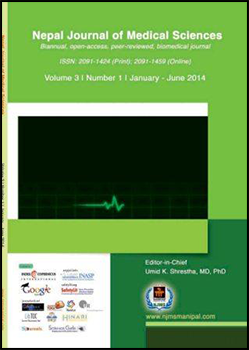Comparision of Antibiotic Susceptility of Levofloxacin with Other Commonly Tested Antibiotics Against Salmonella Enterica Serovar (Typhi And Paratyphi A)
DOI:
https://doi.org/10.3126/njms.v3i1.10344Keywords:
Levofloxacin, Nalidixic acid resistance, Salmonella enterica serovar (Typhi and Paratyphi A)Abstract
Background: Increasing antibiotic resistance of bacteria is a global problem. Fluoroquinolones are recommended as first line therapy for children and adults infected with Salmonella enterica serovar Typhi and Paratyphi A. The purpose of this study was to compare the antibiotic susceptibility pattern of different classes of antibiotics with levofloxacin from blood samples of suspected enteric fever patients visiting Birhospital, Kathmandu.
Methods: Antibiotic susceptibility test was performed by Kirby-Bauerdisc diffusion method as per Clinical Laboratory Standards Institute guideline.
Results: Among 50 isolates of Salmonella enterica, 39 (78%) were S.Typhi and 11 (22%) were S. Paratyphi A. All the isolates were tested against antibiotics, and all isolates were found sensitive to chloramphenicol and ceftriaxone whereas 3 isolates of S. Typhi were resistant to ciprofloxacin and 1 was resistant to levofloxacin. Fluoroquinolone resistant S. ParatyphiA was not observed. Among the 10 (20%) multi drug resistant isolates, only 1 isolate was resistant to levofloxacin which was S. Typhi. Both S.Typhi (96.7%) and S. Paratyphi A (89.4%) were resistant to Nalidixic acid.
Conclusion: High level of nalidixic acid resistance and even some fluoroquinolone resistance showed that the treatment of the enteric fever cannot be relied on the fluoroquinolones.
Nepal Journal of Medical Sciences | Volume 03 | Number 01 | January-June 2014 | Page 19-21
Downloads
Downloads
Published
How to Cite
Issue
Section
License
Copyright © by Nepal Journal of Medical Sciences. The ideas and opinions expressed by authors of articles summarized, quoted, or published in full text in this Journal represents only opinions of authors and do not necessarily reflect the official policy of Nepal Journal of Medical Sciences or the institute with which the author(s) is (are) affiliated, unless so specified.




